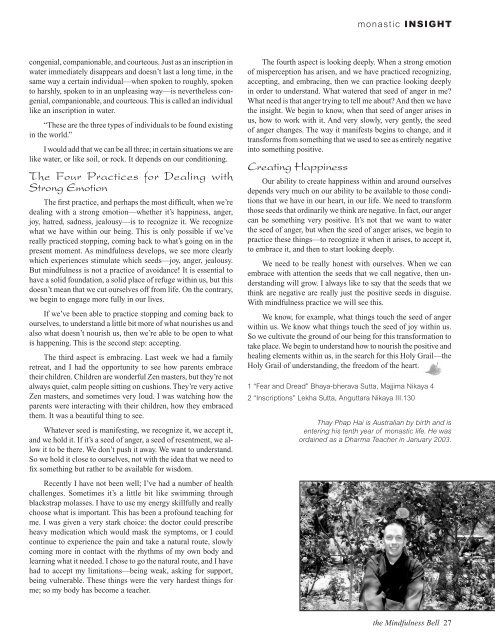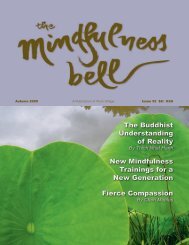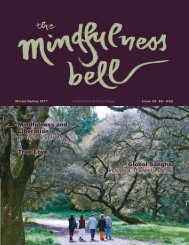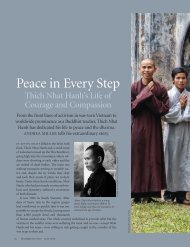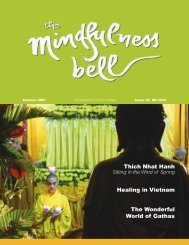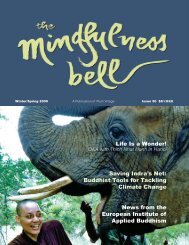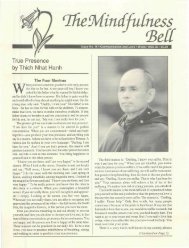monastic INSIGHTK<strong>in</strong>g Arthur and <strong>the</strong> Knights are all sitt<strong>in</strong>g <strong>the</strong>re at <strong>the</strong> RoundTable. K<strong>in</strong>g Arthur stands up and says, “Okay! Before we eat ourmeal, who’s had an adventure this morn<strong>in</strong>g?”(It seems that <strong>the</strong>y had many more adventures <strong>in</strong> those daysthan we do now.)None of <strong>the</strong> Knights of <strong>the</strong> Round Table had anyth<strong>in</strong>g <strong>to</strong> share.<strong>The</strong>y all just sat <strong>the</strong>re.So K<strong>in</strong>g Arthur said, “Well, until we have an adventure, wecan’t sit down <strong>to</strong> our meal.”<strong>The</strong>y’re all th<strong>in</strong>k<strong>in</strong>g, now what k<strong>in</strong>d of adventure could wehave? What are we go<strong>in</strong>g <strong>to</strong> do so we can eat? And <strong>the</strong>n <strong>the</strong> HolyGrail appears, beckon<strong>in</strong>g <strong>the</strong>m on a quest. <strong>The</strong>y decide, all right<strong>the</strong>n, we’re go<strong>in</strong>g <strong>to</strong> set out <strong>in</strong> search of <strong>the</strong> Holy Grail. <strong>The</strong>y ge<strong>to</strong>n<strong>to</strong> <strong>the</strong>ir valiant steeds and tsch-tsch-tsch-tsch plod down <strong>to</strong> aforest, conveniently nearby, which just happens <strong>to</strong> be called <strong>the</strong>Forest of Adventure.Interest<strong>in</strong>gly, <strong>in</strong> this s<strong>to</strong>ry of <strong>the</strong> Holy Grail, although youset out on a quest—you know, <strong>the</strong>se valiant quests, with a bighorse, a big sword, and everyth<strong>in</strong>g—you do not f<strong>in</strong>d <strong>the</strong> Grail,it f<strong>in</strong>ds you. Here we have <strong>the</strong> same teach<strong>in</strong>g as Master L<strong>in</strong>ji, <strong>to</strong>s<strong>to</strong>p our seek<strong>in</strong>g, <strong>to</strong> s<strong>to</strong>p runn<strong>in</strong>g around, and come back <strong>to</strong> whatis go<strong>in</strong>g on right here, because <strong>the</strong> path, <strong>the</strong> Holy Grail, <strong>the</strong> Fores<strong>to</strong>f Adventure, is right underneath our feet. What is important isour will<strong>in</strong>gness <strong>to</strong> undertake this journey, <strong>the</strong> journey of open<strong>in</strong>g<strong>the</strong> heart.So <strong>the</strong>y arrive at <strong>the</strong> outskirts of <strong>the</strong> forest, where <strong>the</strong>y realizethat <strong>the</strong>re are two possibilities. Ei<strong>the</strong>r <strong>the</strong>y all enter <strong>the</strong> forest<strong>to</strong>ge<strong>the</strong>r, <strong>in</strong> search of <strong>the</strong> Holy Grail, or <strong>the</strong>y enter <strong>the</strong> forest separately.Bear <strong>in</strong> m<strong>in</strong>d that up <strong>to</strong> this po<strong>in</strong>t <strong>the</strong>y had traveled <strong>to</strong>ge<strong>the</strong>r<strong>to</strong> get <strong>to</strong> <strong>the</strong> Forest of Adventure, as a Sangha, as a community.When <strong>the</strong>y got <strong>to</strong> <strong>the</strong> Forest of Adventure, <strong>the</strong>y felt, oh, it wouldbe a shame for us all <strong>to</strong> go down that very clear path through <strong>the</strong>forest, but ra<strong>the</strong>r each Knight should enter at a place of his ownchoos<strong>in</strong>g. Only <strong>the</strong>n would it be an adventure.In our journey of practice, <strong>in</strong>itially we are <strong>in</strong> search of someth<strong>in</strong>g—peace, enlightenment, joy, a chocolate donut—that weth<strong>in</strong>k exists outside of ourself. We are carried by <strong>the</strong> energy of<strong>the</strong> Sangha. For <strong>the</strong> real adventure <strong>to</strong> beg<strong>in</strong>, we need <strong>to</strong> discoverand nourish our own aspiration. What is your Holy Grail? Whyare you a practitioner? What br<strong>in</strong>gs you back <strong>to</strong> your Sanghaeach week?To see this, <strong>to</strong> <strong>to</strong>uch this very deep and profound long<strong>in</strong>g <strong>in</strong>your heart is <strong>to</strong> <strong>to</strong>uch your deepest aspiration. <strong>The</strong> Sangha is a placewhere we help each o<strong>the</strong>r <strong>to</strong> realize our deepest aspiration.<strong>The</strong> Sutra on Fear and DreadMany of <strong>the</strong> world’s myths and legends feature this image of<strong>the</strong> forest. In European fairy tales, <strong>to</strong> give just one example, wehave Hansel and Gretel go<strong>in</strong>g <strong>in</strong><strong>to</strong> <strong>the</strong> forest <strong>to</strong> <strong>the</strong> witch’s house.In <strong>the</strong> spiritual traditions as well we have this image of this forest,this place of <strong>the</strong> unknown. In Buddhism, what happened <strong>to</strong>Siddhartha when he decided <strong>to</strong> leave home? Where did he go? Hewent <strong>in</strong><strong>to</strong> <strong>the</strong> forest.26 Summer 2006<strong>The</strong>re is a series of lovely teach<strong>in</strong>gs about Siddhartha, <strong>the</strong>future Buddha, enter<strong>in</strong>g <strong>the</strong> forest. When Siddhartha entered <strong>the</strong>wilderness, he experienced great fear and dread. Any little sound<strong>in</strong> <strong>the</strong> forest, like a stick crack<strong>in</strong>g, he would imag<strong>in</strong>e <strong>to</strong> be a tigercom<strong>in</strong>g <strong>to</strong> eat him up.In one sutra, called “Fear and Dread,” he shares his experienceof enter<strong>in</strong>g <strong>the</strong> forest, this place of mystery. I <strong>in</strong>vite you <strong>to</strong> enjoythis discourse <strong>in</strong> its entirety, as it has much <strong>to</strong> say <strong>to</strong> us. <strong>The</strong> Buddhashares about <strong>the</strong> <strong>in</strong>tense fear and dread that overcame him when heentered <strong>the</strong> forest, <strong>the</strong> place of <strong>the</strong> unknown. Leav<strong>in</strong>g beh<strong>in</strong>d <strong>the</strong>comfortable and familiar, he shares his practice of understand<strong>in</strong>gfear. When <strong>the</strong> fear and dread came upon him he would cont<strong>in</strong>uedo<strong>in</strong>g whatever it was he was do<strong>in</strong>g—sitt<strong>in</strong>g, ly<strong>in</strong>g, stand<strong>in</strong>g—untilhe unders<strong>to</strong>od where <strong>the</strong> fear was com<strong>in</strong>g from.Once we have a solid place of refuge with<strong>in</strong> us, we need <strong>to</strong> staywith what is happen<strong>in</strong>g, not run away, not try <strong>to</strong> distract ourselves.We <strong>in</strong> <strong>the</strong> West have a great tendency <strong>to</strong> do this—anyth<strong>in</strong>g <strong>to</strong> avoidwhat we’re call<strong>in</strong>g here fear and dread. It might be our sadness, ourdepression. <strong>The</strong> Buddha is tell<strong>in</strong>g us <strong>to</strong> dwell with what is be<strong>in</strong>gbrought up for us. Meditation practice is about understand<strong>in</strong>g whowe are, what is go<strong>in</strong>g on with<strong>in</strong> us and transform<strong>in</strong>g <strong>the</strong> experiencesthat we have <strong>in</strong><strong>to</strong> opportunities for <strong>in</strong>sight <strong>to</strong> blossom.Where is <strong>the</strong> Holy Grail? Where is <strong>the</strong> Forest of Adventure,for us as practitioners, for us as cultiva<strong>to</strong>rs? Where is <strong>the</strong> placewhere we feel fear and dread <strong>the</strong> most? Where is <strong>the</strong> place ofmystery? It’s with<strong>in</strong> our heart. Meditation practice by its verynature br<strong>in</strong>gs us back <strong>to</strong> what’s go<strong>in</strong>g on with<strong>in</strong> our body, with<strong>in</strong>our m<strong>in</strong>d. M<strong>in</strong>dfulness practice is about learn<strong>in</strong>g <strong>to</strong> dwell withwhatever is present.<strong>The</strong> Sutra on Inscriptions<strong>The</strong>re is a beautiful teach<strong>in</strong>g on this called “Inscriptions” :“Monks, <strong>the</strong>re are <strong>the</strong>se three types of <strong>in</strong>dividuals <strong>to</strong> befound exist<strong>in</strong>g <strong>in</strong> <strong>the</strong> world. Which three? An <strong>in</strong>dividual like an<strong>in</strong>scription <strong>in</strong> rock, an <strong>in</strong>dividual like an <strong>in</strong>scription <strong>in</strong> soil, andan <strong>in</strong>dividual like an <strong>in</strong>scription <strong>in</strong> water.“And how is an <strong>in</strong>dividual like an <strong>in</strong>scription <strong>in</strong> rock? <strong>The</strong>reis <strong>the</strong> case where a certa<strong>in</strong> <strong>in</strong>dividual is often angered, and hisanger stays with him a long time. Just as an <strong>in</strong>scription <strong>in</strong> rockis not quickly effaced by w<strong>in</strong>d or water and lasts a long time, <strong>in</strong><strong>the</strong> same way a certa<strong>in</strong> <strong>in</strong>dividual is often angered, and his angerstays with him a long time. This is called an <strong>in</strong>dividual like an<strong>in</strong>scription <strong>in</strong> rock.“And how is an <strong>in</strong>dividual like an <strong>in</strong>scription <strong>in</strong> soil? <strong>The</strong>re is<strong>the</strong> case where a certa<strong>in</strong> <strong>in</strong>dividual is often angered, but his angerdoesn’t stay with him a long time. Just as an <strong>in</strong>scription <strong>in</strong> soil isquickly effaced by w<strong>in</strong>d or water and doesn’t last a long time, <strong>in</strong><strong>the</strong> same way a certa<strong>in</strong> <strong>in</strong>dividual is often angered, but his angerdoesn’t stay with him a long time. This is called an <strong>in</strong>dividual likean <strong>in</strong>scription <strong>in</strong> soil.“And how is an <strong>in</strong>dividual like an <strong>in</strong>scription <strong>in</strong> water? <strong>The</strong>reis <strong>the</strong> case where a certa<strong>in</strong> <strong>in</strong>dividual—when spoken <strong>to</strong> roughly,spoken <strong>to</strong> harshly, spoken <strong>to</strong> <strong>in</strong> an unpleas<strong>in</strong>g way—is never<strong>the</strong>less
monastic INSIGHTcongenial, companionable, and courteous. Just as an <strong>in</strong>scription <strong>in</strong>water immediately disappears and doesn’t last a long time, <strong>in</strong> <strong>the</strong>same way a certa<strong>in</strong> <strong>in</strong>dividual—when spoken <strong>to</strong> roughly, spoken<strong>to</strong> harshly, spoken <strong>to</strong> <strong>in</strong> an unpleas<strong>in</strong>g way—is never<strong>the</strong>less congenial,companionable, and courteous. This is called an <strong>in</strong>dividuallike an <strong>in</strong>scription <strong>in</strong> water.“<strong>The</strong>se are <strong>the</strong> three types of <strong>in</strong>dividuals <strong>to</strong> be found exist<strong>in</strong>g<strong>in</strong> <strong>the</strong> world.”I would add that we can be all three; <strong>in</strong> certa<strong>in</strong> situations we arelike water, or like soil, or rock. It depends on our condition<strong>in</strong>g.<strong>The</strong> Four Practices for Deal<strong>in</strong>g withStrong Emotion<strong>The</strong> first practice, and perhaps <strong>the</strong> most difficult, when we’redeal<strong>in</strong>g with a strong emotion—whe<strong>the</strong>r it’s happ<strong>in</strong>ess, anger,joy, hatred, sadness, jealousy—is <strong>to</strong> recognize it. We recognizewhat we have with<strong>in</strong> our be<strong>in</strong>g. This is only possible if we’vereally practiced s<strong>to</strong>pp<strong>in</strong>g, com<strong>in</strong>g back <strong>to</strong> what’s go<strong>in</strong>g on <strong>in</strong> <strong>the</strong>present moment. As m<strong>in</strong>dfulness develops, we see more clearlywhich experiences stimulate which seeds—joy, anger, jealousy.But m<strong>in</strong>dfulness is not a practice of avoidance! It is essential <strong>to</strong>have a solid foundation, a solid place of refuge with<strong>in</strong> us, but thisdoesn’t mean that we cut ourselves off from life. On <strong>the</strong> contrary,we beg<strong>in</strong> <strong>to</strong> engage more fully <strong>in</strong> our lives.If we’ve been able <strong>to</strong> practice s<strong>to</strong>pp<strong>in</strong>g and com<strong>in</strong>g back <strong>to</strong>ourselves, <strong>to</strong> understand a little bit more of what nourishes us andalso what doesn’t nourish us, <strong>the</strong>n we’re able <strong>to</strong> be open <strong>to</strong> whatis happen<strong>in</strong>g. This is <strong>the</strong> second step: accept<strong>in</strong>g.<strong>The</strong> third aspect is embrac<strong>in</strong>g. Last week we had a familyretreat, and I had <strong>the</strong> opportunity <strong>to</strong> see how parents embrace<strong>the</strong>ir children. Children are wonderful Zen masters, but <strong>the</strong>y’re notalways quiet, calm people sitt<strong>in</strong>g on cushions. <strong>The</strong>y’re very activeZen masters, and sometimes very loud. I was watch<strong>in</strong>g how <strong>the</strong>parents were <strong>in</strong>teract<strong>in</strong>g with <strong>the</strong>ir children, how <strong>the</strong>y embraced<strong>the</strong>m. It was a beautiful th<strong>in</strong>g <strong>to</strong> see.Whatever seed is manifest<strong>in</strong>g, we recognize it, we accept it,and we hold it. If it’s a seed of anger, a seed of resentment, we allowit <strong>to</strong> be <strong>the</strong>re. We don’t push it away. We want <strong>to</strong> understand.So we hold it close <strong>to</strong> ourselves, not with <strong>the</strong> idea that we need <strong>to</strong>fix someth<strong>in</strong>g but ra<strong>the</strong>r <strong>to</strong> be available for wisdom.Recently I have not been well; I’ve had a number of healthchallenges. Sometimes it’s a little bit like swimm<strong>in</strong>g throughblackstrap molasses. I have <strong>to</strong> use my energy skillfully and reallychoose what is important. This has been a profound teach<strong>in</strong>g forme. I was given a very stark choice: <strong>the</strong> doc<strong>to</strong>r could prescribeheavy medication which would mask <strong>the</strong> symp<strong>to</strong>ms, or I couldcont<strong>in</strong>ue <strong>to</strong> experience <strong>the</strong> pa<strong>in</strong> and take a natural route, slowlycom<strong>in</strong>g more <strong>in</strong> contact with <strong>the</strong> rhythms of my own body andlearn<strong>in</strong>g what it needed. I chose <strong>to</strong> go <strong>the</strong> natural route, and I havehad <strong>to</strong> accept my limitations—be<strong>in</strong>g weak, ask<strong>in</strong>g for support,be<strong>in</strong>g vulnerable. <strong>The</strong>se th<strong>in</strong>gs were <strong>the</strong> very hardest th<strong>in</strong>gs forme; so my body has become a teacher.<strong>The</strong> fourth aspect is look<strong>in</strong>g deeply. When a strong emotionof misperception has arisen, and we have practiced recogniz<strong>in</strong>g,accept<strong>in</strong>g, and embrac<strong>in</strong>g, <strong>the</strong>n we can practice look<strong>in</strong>g deeply<strong>in</strong> order <strong>to</strong> understand. What watered that seed of anger <strong>in</strong> me?What need is that anger try<strong>in</strong>g <strong>to</strong> tell me about? And <strong>the</strong>n we have<strong>the</strong> <strong>in</strong>sight. We beg<strong>in</strong> <strong>to</strong> know, when that seed of anger arises <strong>in</strong>us, how <strong>to</strong> work with it. And very slowly, very gently, <strong>the</strong> seedof anger changes. <strong>The</strong> way it manifests beg<strong>in</strong>s <strong>to</strong> change, and ittransforms from someth<strong>in</strong>g that we used <strong>to</strong> see as entirely negative<strong>in</strong><strong>to</strong> someth<strong>in</strong>g positive.Creat<strong>in</strong>g Happ<strong>in</strong>essOur ability <strong>to</strong> create happ<strong>in</strong>ess with<strong>in</strong> and around ourselvesdepends very much on our ability <strong>to</strong> be available <strong>to</strong> those conditionsthat we have <strong>in</strong> our heart, <strong>in</strong> our life. We need <strong>to</strong> transformthose seeds that ord<strong>in</strong>arily we th<strong>in</strong>k are negative. In fact, our angercan be someth<strong>in</strong>g very positive. It’s not that we want <strong>to</strong> water<strong>the</strong> seed of anger, but when <strong>the</strong> seed of anger arises, we beg<strong>in</strong> <strong>to</strong>practice <strong>the</strong>se th<strong>in</strong>gs—<strong>to</strong> recognize it when it arises, <strong>to</strong> accept it,<strong>to</strong> embrace it, and <strong>the</strong>n <strong>to</strong> start look<strong>in</strong>g deeply.We need <strong>to</strong> be really honest with ourselves. When we canembrace with attention <strong>the</strong> seeds that we call negative, <strong>the</strong>n understand<strong>in</strong>gwill grow. I always like <strong>to</strong> say that <strong>the</strong> seeds that weth<strong>in</strong>k are negative are really just <strong>the</strong> positive seeds <strong>in</strong> disguise.With m<strong>in</strong>dfulness practice we will see this.We know, for example, what th<strong>in</strong>gs <strong>to</strong>uch <strong>the</strong> seed of angerwith<strong>in</strong> us. We know what th<strong>in</strong>gs <strong>to</strong>uch <strong>the</strong> seed of joy with<strong>in</strong> us.So we cultivate <strong>the</strong> ground of our be<strong>in</strong>g for this transformation <strong>to</strong>take place. We beg<strong>in</strong> <strong>to</strong> understand how <strong>to</strong> nourish <strong>the</strong> positive andheal<strong>in</strong>g elements with<strong>in</strong> us, <strong>in</strong> <strong>the</strong> search for this Holy Grail—<strong>the</strong>Holy Grail of understand<strong>in</strong>g, <strong>the</strong> freedom of <strong>the</strong> heart.1 “Fear and Dread” Bhaya-bherava Sutta, Majjima Nikaya 42 “Inscriptions” Lekha Sutta, Anguttara Nikaya III.130Thay Phap Hai is Australian by birth and isenter<strong>in</strong>g his tenth year of monastic life. He wasorda<strong>in</strong>ed as a Dharma Teacher <strong>in</strong> January 2003.<strong>the</strong> M<strong>in</strong>dfulness Bell 27


